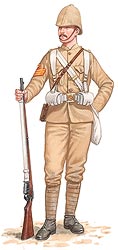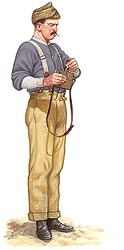The Tirah Campaign Recollections
of Surgeon Captain AE Masters
 |
| Colour Sergeant,
Khaki drill. (Click to enlarge) |
1st Queen’s returned to Peshawar after six weeks marching and counter-marching and were then transferred to the Tirah Field Force which took to the field against the Afridis and Orakzais after they began to raid across the frontier. Throughout October and November the Battalion was on punitive operations deep inside tribal territory until the force withdrew to Peshawar in December at the onset of winter. Further operations were mounted from Peshawar and the Khyber valley in 1898 and peace was finally restored in May following which the Queen’s returned to Rawalpindi. They had incurred eleven killed and eighteen wounded during the campaign.
 |
| Private in "grey back" shirt worn over a woolen vest (Click to enlarge) |
Surgeon Captain Masters was attached to the Queen’s and described events in a number of letters to his wife. His first, dated 16th October 1897, was sent from Kohat. In it he said:
“I was suddenly ordered to prepare to accompany the Queen’s who were to march next day at 7am. We set off by three marches going through some peaceful Afridi country and down here on the third day, settling down for four or five days in camp while the brigades were getting together and getting transport, which is to be entirely mule. General Symonds commands the division and General Goslee the brigade we are in.
The actual peace garrison here is a very small one, a couple of forts and outlying defensive posts. This regiment has just returned from the Mohmand expedition where they were in the brigade that had five hours of the hottest night firing from the enemy that has been known for a long time in frontier warfare. They seem a very nice lot of fellows.”
His next letter was from Shinwari which he described as an enormous base camp spread over several miles of country with innumerable unit camps and stores on the hill sides. The country they had been coming through from Kohat reminded him of parts of Scotland with hills covered with bush which in the distance looked like larches. The valley was cultivated and fruitful although rather bare in parts. The road was undulating and very dusty although for that part of the world well made, and later terraced and graduated by a regiment of Pioneers.
The immediate objective of the force was the Sanpagha Pass which opened on to the central Tirah. On 30th October Masters sent a postcard which said: “Sanpagha Pass taken yesterday. My regiment, Queen’s, in the front line with 4th Gurkhas and 3rd Sikhs, took the pass. Very steep, about 2000 feet up from our camp at Karappa. Gradually getting into shape. Transport bad, no food or baggage last night. Pleasures of campaigning! Burning villages all around. Bullets flying about merrily yesterday. Casualties 2 killed, 18 wounded. 1 killed and 8 wounded of the Queen’s.”
Masters was much intrigued by the appearance and way of life of the tribesmen. He wrote that:
“On our foraging expedition it has been very clear that the inhabitants of this country are a rum lot, as each single house is built in the style of a fortification, in this way each house is square with only one door or other means of exit. The lower part is for storage and the third story is practically only a look-out place to spot when their neighbour is going to attack them. It seems evident that each man is his neighbour’s enemy. The second floor is loop-holed in most cases and it is said that most of the year a man does not venture out of his house except during reaping times when all the feuds are temporarily brought into a state of truce. In one house I saw a loop-hole about four feet up and the only use it could ever have was to form a place to shoot into a corresponding loop-hole in a neighbour’s house. The consequence of this state of internal feud seems to be that they are very good shots indeed, especially at long range nearer than which they dare not as a rule approach, as they have a great idea of keeping themselves hid, thus making a regular guerilla warfare in which very many of the enemy are never seen.”
Towards the end of the campaign there were meetings with the tribesmen about which Masters wrote:
“There are a number of ‘Jirgahs’ of about 200 men, very fine men with dirty clothing and grass shoes for their feet. They all have a certain Jewish look about them, as all Pathans have, and some are quite fair skin although dark in hair. They present upon the whole a most ruffianly aspect. They appear to be half starved and have a very distant acquaintance with the commodity known as water. It is quite refreshing talking and looking at them after the cringing Hindoo, who is such a miserable specimen as a rule. One can’t help admiring their independent and careless air. Each section has slight differences in clothing, but mostly they wear white linen loose knickers coming midway between knee and foot, and a sort of plaid or shawl of grey cloth and a turban of the same colour with a sort of skull cap, thick with grease and dirt, under the turban.
The pictures in the papers give a very erroneous idea of them, in fact they are mostly done by fanciful draughtsmen in Fleet Street. Their average height is about 5’10 but many are over 6 feet and one or two 6’4 to 5, splendidly built in proportion, with a long steady swing of a gait while walking.”
Related
